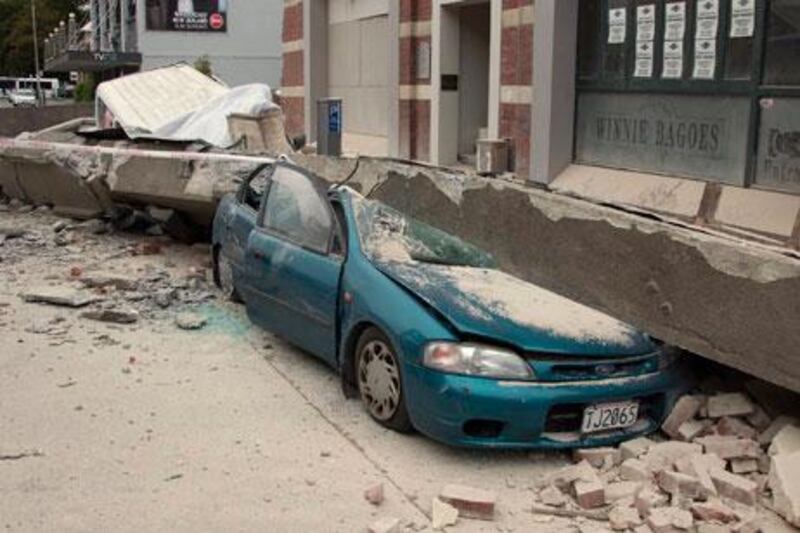CHRISTCHURCH, NEW ZEALAND // A powerful earthquake has struck one of New Zealand's biggest cities at the height of a busy workday, toppling tall buildings and churches, crushing buses and killing at least 65 people in one of the country's worst natural disasters.
It was the second major quake to hit Christchurch, a city of 350,000, in five months, although today's 6.3-magnitude temblor caused far more destruction than a more powerful September quake that struck before dawn on a weekend.
"It is a just a scene of utter devastation," the prime minister, John Key, said after rushing to the city within hours of the quake. He said the death toll was 65, and may rise. "This may be New Zealand's darkest day."
The spire of the city's well-known stone cathedral toppled into a central square, while video footage showed multistory buildings collapsed in on themselves, and others with walls that had fallen into streets strewn with bricks and shattered concrete.
Sidewalks and roads were cracked and split, while thousands of dazed, screaming and crying residents wandered through the streets as sirens blared. Groups of people helped victims clutching bleeding wounds, and others were carried to private vehicles in makeshift stretchers fashioned from rugs or bits of debris.
The mayor of Christchurch, Bob Parker, declared a state of emergency and ordered people to evacuate the city centre. Troops were deployed to help people get out and to throw up a security cordon around the struck area, said Bill English, the deputy prime minister.
The airport was closed, and Christchurch Hospital was briefly evacuated before it was deemed safe and patients were returned. Power and telephone lines were knocked out, and pipes burst, flooding the streets with water. Some cars parked on the street were buried under rubble.
Some people were stuck in office towers and firefighters climbed extension ladders to pluck people trapped on roofs to safety. A crane lifted a team of rescuers on a platform to one group of survivors in a high-rise. Plumes of grey smoke drifted into the air at several points around the city from fires burning in the rubble.
Mr Key held an emergency cabinet meeting then rushed to the struck city to observe the scene.
He said eight or nine buildings had collapsed, and that officials were working as fast as they can to free an unknown number of people who were trapped.
New Zealand police said in a statement that reports of fatalities included that two buses had been crushed by falling buildings.
Gary Moore said he and 19 other colleagues were trapped in their 12th floor office after the stairwell collapsed in the quake. He did not know if people on other floors were trapped.
"We watched the cathedral collapse out our window while we were holding onto the walls," Mr Moore said. "Every aftershock sends us rushing under the desks. It's very unnerving but we can clearly see there are other priorities out the window. There has been a lot of damage and I guess people are attending to that before they come and get us."
The multistory Pyne Gould Guinness Building, housing more than 200 workers, collapsed and an unknown number of people are trapped inside. Television pictures showed rescuers, many of them office workers, dragging severely injured people from the rubble. Many had blood streaming down their faces. Screams could be heard from those still trapped.
Mr Parker, the mayor, said he was on the top floor of the city council building when the quake hit just before 1pm local time, throwing him across the room.
"I got down onto the street and there were scenes of great confusion, a lot of very upset people," he said. "I know of people in our building who are injured and I've had some reports of serious injuries throughout the city."
The US Geological Survey said the temblor was centred 5 kilometres from the city at a depth of 4km. Two large aftershocks - one magnitude 5.6 and another 5.5 - hit the city within two hours, and officials warned people to stay away from damaged buildings because of the danger of further collapses.
"When the shaking had stopped I looked out of the window, which gives a great view onto Christchurch, and there was just dust," said the city councilman Barry Corbett, who was on one of the top floors of the city council building when the quake struck. "It was evident straight away that a lot of buildings had gone."
A search and rescue team was being flown in from Australia to help in the recovery, and the Australian prime minister, Julia Gillard, said she had offered Mr Key any other support he requested.
The US Geological Survey said the latest quake was part of the "aftershock sequence" following the 7.1 magnitude earthquake on September 4. That quake wrecked hundreds of buildings, inflicted an estimated 4 billion New Zealand dollars (Dh11bn) in damage, but caused no deaths.
A strong aftershock in December caused further damage to buildings. The city, considered a tourist centre, was still rebuilding from those quakes when Tuesday's temblor hit.





